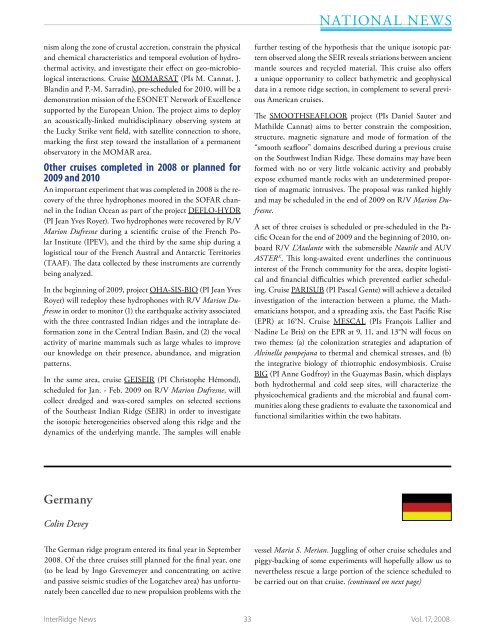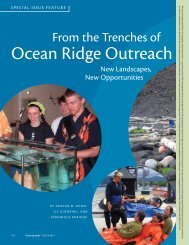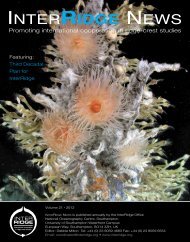Full version, lower resolution, 3.25MB - InterRidge
Full version, lower resolution, 3.25MB - InterRidge
Full version, lower resolution, 3.25MB - InterRidge
Create successful ePaper yourself
Turn your PDF publications into a flip-book with our unique Google optimized e-Paper software.
National News<br />
nism along the zone of crustal accretion, constrain the physical<br />
and chemical characteristics and temporal evolution of hydrothermal<br />
activity, and investigate their effect on geo-microbiological<br />
interactions. Cruise MOMARSAT (PIs M. Cannat, J.<br />
Blandin and P.-M. Sarradin), pre-scheduled for 2010, will be a<br />
demonstration mission of the ESONET Network of Excellence<br />
supported by the European Union. The project aims to deploy<br />
an acoustically-linked multidisciplinary observing system at<br />
the Lucky Strike vent field, with satellite connection to shore,<br />
marking the first step toward the installation of a permanent<br />
observatory in the MOMAR area.<br />
Other cruises completed in 2008 or planned for<br />
2009 and 2010<br />
An important experiment that was completed in 2008 is the recovery<br />
of the three hydrophones moored in the SOFAR channel<br />
in the Indian Ocean as part of the project DEFLO-HYDR<br />
(PI Jean Yves Royer). Two hydrophones were recovered by R/V<br />
Marion Dufresne during a scientific cruise of the French Polar<br />
Institute (IPEV), and the third by the same ship during a<br />
logistical tour of the French Austral and Antarctic Territories<br />
(TAAF). The data collected by these instruments are currently<br />
being analyzed.<br />
In the beginning of 2009, project OHA-SIS-BIO (PI Jean Yves<br />
Royer) will redeploy these hydrophones with R/V Marion Dufresne<br />
in order to monitor (1) the earthquake activity associated<br />
with the three contrasted Indian ridges and the intraplate deformation<br />
zone in the Central Indian Basin, and (2) the vocal<br />
activity of marine mammals such as large whales to improve<br />
our knowledge on their presence, abundance, and migration<br />
patterns.<br />
In the same area, cruise GEISEIR (PI Christophe Hémond),<br />
scheduled for Jan. - Feb. 2009 on R/V Marion Dufresne, will<br />
collect dredged and wax-cored samples on selected sections<br />
of the Southeast Indian Ridge (SEIR) in order to investigate<br />
the isotopic heterogeneities observed along this ridge and the<br />
dynamics of the underlying mantle. The samples will enable<br />
further testing of the hypothesis that the unique isotopic pattern<br />
observed along the SEIR reveals striations between ancient<br />
mantle sources and recycled material. This cruise also offers<br />
a unique opportunity to collect bathymetric and geophysical<br />
data in a remote ridge section, in complement to several previous<br />
American cruises.<br />
The SMOOTHSEAFLOOR project (PIs Daniel Sauter and<br />
Mathilde Cannat) aims to better constrain the composition,<br />
structure, magnetic signature and mode of formation of the<br />
“smooth seafloor” domains described during a previous cruise<br />
on the Southwest Indian Ridge. These domains may have been<br />
formed with no or very little volcanic activity and probably<br />
expose exhumed mantle rocks with an undetermined proportion<br />
of magmatic intrusives. The proposal was ranked highly<br />
and may be scheduled in the end of 2009 on R/V Marion Dufresne.<br />
A set of three cruises is scheduled or pre-scheduled in the Pacific<br />
Ocean for the end of 2009 and the beginning of 2010, onboard<br />
R/V L’Atalante with the submersible Nautile and AUV<br />
ASTER X . This long-awaited event underlines the continuous<br />
interest of the French community for the area, despite logistical<br />
and financial difficulties which prevented earlier scheduling.<br />
Cruise PARISUB (PI Pascal Gente) will achieve a detailed<br />
investigation of the interaction between a plume, the Mathematicians<br />
hotspot, and a spreading axis, the East Pacific Rise<br />
(EPR) at 16°N. Cruise MESCAL (PIs François Lallier and<br />
Nadine Le Bris) on the EPR at 9, 11, and 13°N will focus on<br />
two themes: (a) the colonization strategies and adaptation of<br />
Alvinella pompejana to thermal and chemical stresses, and (b)<br />
the integrative biology of thiotrophic endosymbiosis. Cruise<br />
BIG (PI Anne Godfroy) in the Guaymas Basin, which displays<br />
both hydrothermal and cold seep sites, will characterize the<br />
physicochemical gradients and the microbial and faunal communities<br />
along these gradients to evaluate the taxonomical and<br />
functional similarities within the two habitats.<br />
Germany<br />
Colin Devey<br />
The German ridge program entered its final year in September<br />
2008. Of the three cruises still planned for the final year, one<br />
(to be lead by Ingo Grevemeyer and concentrating on active<br />
and passive seismic studies of the Logatchev area) has unfortunately<br />
been cancelled due to new propulsion problems with the<br />
vessel Maria S. Merian. Juggling of other cruise schedules and<br />
piggy-backing of some experiments will hopefully allow us to<br />
nevertheless rescue a large portion of the science scheduled to<br />
be carried out on that cruise. (continued on next page)<br />
<strong>InterRidge</strong> News 33 Vol. 17, 2008
















